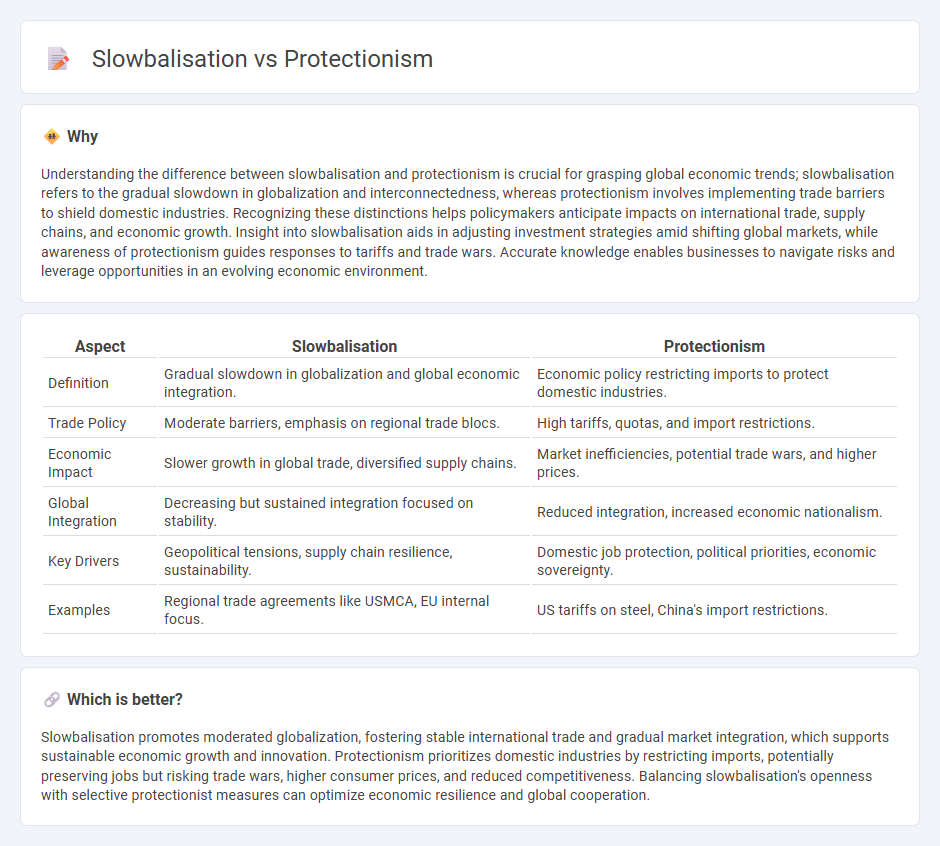
Slowbalisation reflects a gradual deceleration in global economic integration, emphasizing regional trade and supply chain resilience over rapid globalization. Protectionism involves government policies that restrict imports through tariffs and quotas to shield domestic industries from foreign competition. Explore the dynamics and impacts of slowbalisation and protectionism on global markets and economic growth.
Why it is important
Understanding the difference between slowbalisation and protectionism is crucial for grasping global economic trends; slowbalisation refers to the gradual slowdown in globalization and interconnectedness, whereas protectionism involves implementing trade barriers to shield domestic industries. Recognizing these distinctions helps policymakers anticipate impacts on international trade, supply chains, and economic growth. Insight into slowbalisation aids in adjusting investment strategies amid shifting global markets, while awareness of protectionism guides responses to tariffs and trade wars. Accurate knowledge enables businesses to navigate risks and leverage opportunities in an evolving economic environment.
Comparison Table
| Aspect | Slowbalisation | Protectionism |
|---|---|---|
| Definition | Gradual slowdown in globalization and global economic integration. | Economic policy restricting imports to protect domestic industries. |
| Trade Policy | Moderate barriers, emphasis on regional trade blocs. | High tariffs, quotas, and import restrictions. |
| Economic Impact | Slower growth in global trade, diversified supply chains. | Market inefficiencies, potential trade wars, and higher prices. |
| Global Integration | Decreasing but sustained integration focused on stability. | Reduced integration, increased economic nationalism. |
| Key Drivers | Geopolitical tensions, supply chain resilience, sustainability. | Domestic job protection, political priorities, economic sovereignty. |
| Examples | Regional trade agreements like USMCA, EU internal focus. | US tariffs on steel, China's import restrictions. |
Which is better?
Slowbalisation promotes moderated globalization, fostering stable international trade and gradual market integration, which supports sustainable economic growth and innovation. Protectionism prioritizes domestic industries by restricting imports, potentially preserving jobs but risking trade wars, higher consumer prices, and reduced competitiveness. Balancing slowbalisation's openness with selective protectionist measures can optimize economic resilience and global cooperation.
Connection
Slowbalisation, characterized by a deceleration in global trade growth, fosters protectionism as countries implement tariffs and trade barriers to shield domestic industries from external competition. Rising geopolitical tensions and supply chain vulnerabilities intensify these protectionist measures, disrupting economic integration and limiting cross-border investment. This reciprocal relationship undermines multilateral trade agreements and contributes to fragmented global markets, restraining economic growth and innovation.
Key Terms
Tariffs
Protectionism emphasizes the use of tariffs to shield domestic industries from foreign competition by increasing the cost of imported goods, thereby encouraging consumers to buy locally-produced items. Slowbalisation represents a shift towards moderating global trade growth, often leading to selective tariff adjustments that balance domestic economic interests with global supply chain stability. Explore deeper insights on how tariffs shape the evolving landscape between protectionism and slowbalisation.
Trade Barriers
Trade barriers such as tariffs, quotas, and import restrictions are central to protectionism, aiming to shield domestic industries from foreign competition and preserve jobs. Slowbalisation reflects a gradual retreat from globalization, where countries cautiously reduce dependency on global supply chains but maintain selective openness, often easing certain trade barriers to balance national security with economic growth. Explore more to understand how these contrasting approaches shape global trade policies and economic trends.
Global Supply Chains
Protectionism disrupts global supply chains by promoting tariffs and trade barriers that increase costs and limit market access, while slowbalisation reflects a strategic deceleration in globalization driven by risk management and regionalization. Multinational corporations adapt by diversifying suppliers and reshoring production to mitigate vulnerabilities and enhance supply chain resilience. Explore how these shifts reshape global trade dynamics and impact economic growth.
Source and External Links
Protectionism - Definition, Types, Advantages and ... - Protectionism is a trade policy used by governments to support domestic producers by imposing tariffs, quotas, and subsidies to restrict foreign goods and services in the marketplace, protecting developing industries from foreign competition.
What is trade protectionism? - I by IMD - Protectionism involves government measures that raise the price or limit availability of imports to favor domestic producers, but can lead to trade tensions and unintended economic consequences such as increased costs for downstream industries.
Protectionism - Protectionism is an economic policy restricting imports through tariffs, quotas, subsidies, administrative barriers, or anti-dumping laws primarily to shield domestic jobs and industries from foreign competition.
 dowidth.com
dowidth.com